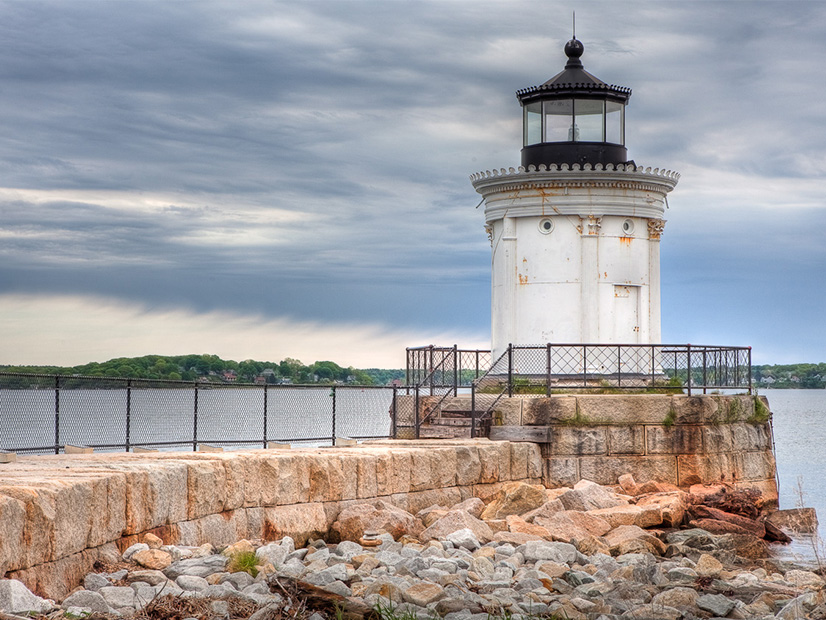
Maine officials are planning to release the findings of the state’s study of offshore wind port opportunities this fall, according to Matt Burns, director of ports and marine transportation at the state Department of Transportation (DOT).
The study, which Gov. Janet Mills announced in March 2020, includes a phase 1 review of the Port of Searsport and a phase 2 review of statewide port facilities, Burns said at the University of Maine’s American Floating Offshore Wind Technical Summit on Thursday.
“We have a longstanding, three-port strategy that we’re hoping will play a role in offshore wind development in the state,” he said.
The target ports, located in Portland, Searsport and Eastport, are spread out strategically along the state’s coastline. But the review is looking at other locations as well.
When the reviews are done, state officials will have a better idea of what type of offshore wind facilities Searsport can handle and what roles other sites could fill, such as maintenance and operations, crew transfer and warehousing.
“We hope to emerge with an offshore wind port strategy that is refined with input from the Maine Offshore Wind Roadmap Advisory Committee as well,” Burns said. (See Roadmap Initiative Set to Hone Maine’s OSW Goal.)
Early Findings
In reviewing the facilities at Searsport, Burns said, DOT determined that the port likely would need a longer wharf to accommodate loading and unloading of cargo. It also could need a concrete bulkhead to accommodate wheeled cargo, more upload acreage with heavy-duty loading capacity and possible dredging to allow safe passage of cargo ships.
DOT is also looking at Mason Station, an abandoned power plant in Wiscasset, Maine. The site, Burns said, is close to Searsport, and has existing infrastructure that could be built out.
It also checks other boxes, such as deep-water access and significant open acreage, he said.
South Portland also has several locations with existing infrastructure that has a large amount of acreage available, and there are existing port facilities in the area that could pivot to offshore wind-related activities, according to Burns.
The property under consideration in Eastport, he said, is “significantly larger” and has “a lot of strengths” in terms of offshore wind support.
Everything under consideration for the state’s port study is “conceptual” right now, Burns said, adding that DOT is in the planning phase so it can develop a strategy “the right way.”
“Stakeholder engagement is critical,” he said. “We want to be prepared to have our plan and be able to grow with this industry as it emerges in the state.”
West Coast Port Progress
The Port of Humboldt Bay in Northern California is preparing to become what its executive director, Larry Oetker, says will be “California’s new offshore wind port.”
The deep-water port is only 21 miles from the U.S. Bureau of Ocean Energy Management’s Humboldt wind energy area, and its central location on the West Coast makes it accessible for the proposed Morro Bay wind area between San Francisco and Los Angeles. It also offers many benefits for offshore wind development, including hundreds of acres of vacant industrial land, Oetker said during the summit.
In its master plan for offshore wind facility expansion, Humboldt Bay is considering a “clustered” approach, he said.
“We heard the industry loud and clear, and they said that in order to drive down costs, it would be best if [manufacturing and component staging, assembly and transportation] could be done all in one port, or at least as much as possible,” he said.
In July, California appropriated $20 million for offshore wind activities, including $11 million to help jumpstart work at Humboldt Bay. The port also has applied for a $56 million infrastructure development grant to begin phase 1 of its 168-acre master plan.
In October, Oetker said, the port plans to begin the environmental review and permitting for the plan. Construction could begin in the 2024-2025 time frame, he added, noting that any plans for construction are contingent on the port’s project permitting and the timing of BOEM’s leasing activities for the Humboldt and Morro Bay call areas.
“Our goal is to get ahead of the curve and to provide certainty for the port, but there’s kind of a chicken-and-the-egg situation on the West Coast,” he said. “The developers don’t want to develop until they actually have leases from BOEM, and then the ports can’t develop unless they have a tenant.”
Once the port has a tenant in place, he added, it will fine-tune its plans to match up with the tenant’s offshore wind project development strategy.
“We want to have a seamless transition from conceptual plan to actual project implementation that meets the needs of the industry … but the longer BOEM delays, then the longer our time period will be on the port development side.”
Oetker expects BOEM will lease both the Humboldt and Morro Bay wind areas in mid-2022.


